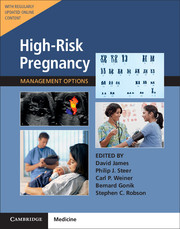Book contents
- Frontmatter
- Contents
- List of Contributors
- Preface
- Section 1 Prepregnancy Problems
- Section 2 Early Prenatal Problems
- Section 3 Late Prenatal – Fetal Problems
- 9 Prenatal Fetal Surveillance
- 10 Fetal Growth Disorders
- 11 Disorders of Amniotic Fluid
- 12 Fetal Hemolytic Disease
- 13 Fetal Thrombocytopenia
- 14 Fetal Cardiac Arrhythmias
- 15 Fetal Cardiac Abnormalities
- 16 Fetal Craniospinal and Facial Abnormalities
- 17 Fetal Genitourinary Abnormalities
- 18 Fetal Gastrointestinal and Abdominal Abnormalities
- 19 Fetal Skeletal Abnormalities
- 20 Fetal Tumors
- 21 Fetal Hydrops
- 22 Fetal Death
- Section 4 Problems Associated with Infection
- Section 5 Late Pregnancy – Maternal Problems
- Section 6 Late Prenatal – Obstetric Problems
- Section 7 Postnatal Problems
- Section 8 Normal Values
- Index
12 - Fetal Hemolytic Disease
from Section 3 - Late Prenatal – Fetal Problems
- Frontmatter
- Contents
- List of Contributors
- Preface
- Section 1 Prepregnancy Problems
- Section 2 Early Prenatal Problems
- Section 3 Late Prenatal – Fetal Problems
- 9 Prenatal Fetal Surveillance
- 10 Fetal Growth Disorders
- 11 Disorders of Amniotic Fluid
- 12 Fetal Hemolytic Disease
- 13 Fetal Thrombocytopenia
- 14 Fetal Cardiac Arrhythmias
- 15 Fetal Cardiac Abnormalities
- 16 Fetal Craniospinal and Facial Abnormalities
- 17 Fetal Genitourinary Abnormalities
- 18 Fetal Gastrointestinal and Abdominal Abnormalities
- 19 Fetal Skeletal Abnormalities
- 20 Fetal Tumors
- 21 Fetal Hydrops
- 22 Fetal Death
- Section 4 Problems Associated with Infection
- Section 5 Late Pregnancy – Maternal Problems
- Section 6 Late Prenatal – Obstetric Problems
- Section 7 Postnatal Problems
- Section 8 Normal Values
- Index
Summary
Introduction
Rhesus alloimmunization has become a rare clinical entity, at least in industrialized nations. It is more than 80 years since neonatal hydrops, anemia, and jaundice were first recognized as a single disease characterized by perinatal hepatosplenomegaly, extramedullary hematopoiesis, and nucleated red blood cells (RBCs) on the peripheral smear. What followed is a fetal success story. Levine and coworkers identified a decade later that the rhesus (Rh) antibodies on the RBCs of affected but not unaffected neonates were the cause of the anemia. The basic “story” was 60% completed 7 years later when Chown proved that transplacental fetal-to-maternal hemorrhage was a cause of maternal isoimmunization. In 1961, hemolytic anemia became the first treatable fetal disease after Liley characterized its natural history and then successfully transfused affected fetuses intraperitoneally with adult RBCs. Freda and colleagues completed the basic story when they demonstrated in 1964 that passive immunization of Rh-negative individuals with Rh-positive antibodies prior to purposeful exposure to Rh-positive RBCs prevented immunization.
Since then, more has been progressively learned about the intricacies of this complex disease, and incremental progress on the clinical side has rendered fetal hemolytic disease a rare cause of perinatal morbidity and mortality in the industrialized world. Three key developments should be highlighted in this development. First, Rodeck and associates achieved the first high survival rate for hydropic fetuses using fetoscopic intravascular transfusion in 1981. Second, in 2000, Mari and coworkers demonstrated that the majority of moderately to severely anemic fetuses were noninvasively identifiable by the measurement of the fetal middle cerebral artery (MCA) peak velocity, essentially ending the need for amniocentesis and reducing that for fetal blood sampling. Thirdly, the discovery of cell-free fetal DNA (cffDNA) in the maternal circulation by Holzgreve and colleagues in response to Lo and associates’ determination of fetal sex in a maternal blood led to the noninvasive genotyping of fetal Rh genes in many countries.
Incidence
The development and implementation of rhesus immunoprophylaxis has diminished the prevalence of Rh sensitization, with the result that sensitization to other antigen groups is relatively commoner (Table 12.1). Yet anti-D antibody remains the prototype for maternal RBC alloimmunization and is used for illustration throughout this chapter.
- Type
- Chapter
- Information
- High-Risk Pregnancy: Management OptionsFive-Year Institutional Subscription with Online Updates, pp. 281 - 308Publisher: Cambridge University PressFirst published in: 2017
- 1
- Cited by



